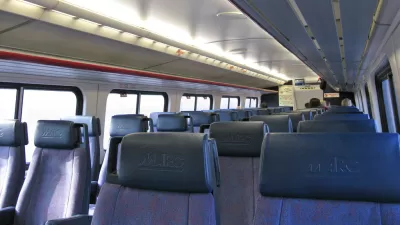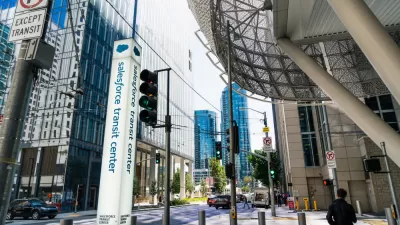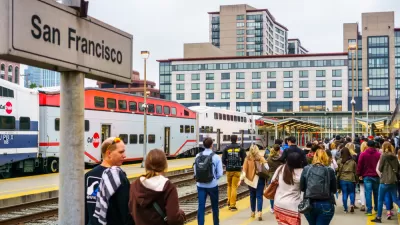Despite a flurry of new commuter rail lines in operation, ridership increased a mere .5% during a record year for transit. Worse yet, some of the newer lines saw the greatest decreases. The answer: increase service to attract riders.

Tod Newcombe, Senior Editor of Governing's Urban Notebook, looks at the problem, and offers one potential solution.
Last year, when the "U.S. Experienced It's Second-Highest Transit Ridership Since 1957", commuter rail ridership increased .5% while total transit ridership jumped 1.5%. In addition, "10 out of 28 systems lost riders; decreases occurred at some of the newest commuter lines..."
As the American Public Transportation Association (APTA) report issued last March posted here notes, commuter rail was public transit's worst performer, behind light rail, heavy rail, and large bus systems.
The biggest problem commuter rail faces is that its customer base lives in far-flung suburbs where cars are used for just about everything. “You are trying to attract people who are the least likely to use transit in the first place,” says Yonah Freemark, editor of The Transport Politic.
According to Wikipedia, "Northstar runs 40 miles (64 km) from Big Lake to downtown Minneapolis at Target Field using existing track and right-of-way owned by the BNSF Railway. Extension plans are on indefinite hold due to insufficient ridership."
The other three lines noted by Newcombe saw significantly greater ridership losses. Rail Runner (Albuquerque, N.M.), Trinity Railway Express serving Dallas-Fort Worth, and Music City Star (Nashville, Tenn) saw ridership drops of 9%, 7.7%, and 6.4% respectively. For other commuter rail lines, some of which saw substantial ridership gains, see page 5 of the March, 2013 American Public Transportation Report (PDF).
Newcombe writes that the solution, though sounding "counterintuitive, involves more service", though he doesn't suggest building extensions. He points to the Metro-North Railroad, with ridership up 1.2% last year. "After watching ridership decline for decades on its line, the MTA added more off-peak and weekend service, as well as another 187 trains, representing the most ambitious service expansion in its 30-year history. As a result, ridership has grown robustly."
Freemark agrees with this strategy. “Too many of today’s commuter rail lines are wasted infrastructure. Can you imagine a highway where the lanes are only open during rush hour?”
Neither Newcombe nor Freemark address the funding challenge - each additional train the agency deploys amounts to a significant operational expense in labor and fuel, expenses not incurred by empty highway lanes. In fact, when budgets are tight, agencies will often seek to cut trains as well as raise fares.
An extreme example, a 44% reduction in service was proposed for Caltrain in the Bay Area two years ago. However, funds were found with the help of the regional transportation agency, and service was reduced by almost 10% instead. The train line's ridership increased a staggering 13% last year.
FULL STORY: Commuter Rail Ridership Declining Despite Increase in Lines

Alabama: Trump Terminates Settlements for Black Communities Harmed By Raw Sewage
Trump deemed the landmark civil rights agreement “illegal DEI and environmental justice policy.”

Study: Maui’s Plan to Convert Vacation Rentals to Long-Term Housing Could Cause Nearly $1 Billion Economic Loss
The plan would reduce visitor accommodation by 25% resulting in 1,900 jobs lost.

Planetizen Federal Action Tracker
A weekly monitor of how Trump’s orders and actions are impacting planners and planning in America.

Wind Energy on the Rise Despite Federal Policy Reversal
The Trump administration is revoking federal support for renewable energy, but demand for new projects continues unabated.

Passengers Flock to Caltrain After Electrification
The new electric trains are running faster and more reliably, leading to strong ridership growth on the Bay Area rail system.

Texas Churches Rally Behind ‘Yes in God’s Back Yard’ Legislation
Religious leaders want the state to reduce zoning regulations to streamline leasing church-owned land to housing developers.
Urban Design for Planners 1: Software Tools
This six-course series explores essential urban design concepts using open source software and equips planners with the tools they need to participate fully in the urban design process.
Planning for Universal Design
Learn the tools for implementing Universal Design in planning regulations.
Caltrans
Smith Gee Studio
Institute for Housing and Urban Development Studies (IHS)
City of Grandview
Harvard GSD Executive Education
Toledo-Lucas County Plan Commissions
Salt Lake City
NYU Wagner Graduate School of Public Service





























